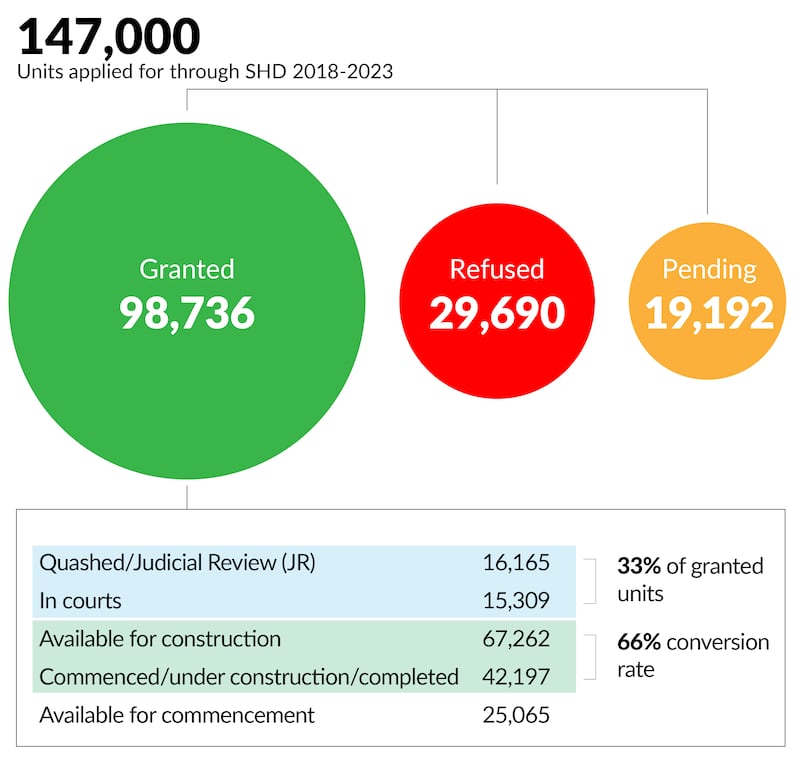More than two-thirds of the 147,000 housing units applied for under the Government’s now-defunct strategic housing development (SHD) system remain undeveloped, according to figures sourced from the industry.
The SHD system was introduced in 2017 to fast-track the delivery of housing by allowing direct planning applications to An Bord Pleanála, the planning appeals authority.
The move allowed developers of housing projects involving 100 or more units to skip the initial local authority phase of the planning process in a bid to speed up the delivery of vital housing projects.
It was, however, scrapped last year after SHD projects resulted in 48 judicial review (JR) cases in the High Court.
READ MORE
Industry figures show that of the 147,000 units applied for under the scheme between 2017 and 2023, 98,736 were granted planning while 29,690 were refused by An Bord Pleanála.
A third of the units that were granted planning permission (31,474) were either quashed or remain stalled by legal action, the figures show.

A further 19,192 units remain in the pipeline, on hold because of the decision-making logjam at An Bord Pleanála. The average period they have been pending is 95 weeks. Planning determinations were meant to take 16 weeks.
Of the 67,262 units that were granted permission and did not end up in legal action, the figures show 42,197 are either commenced, under construction or completed, while a further 25,065 units are available for commencement.
Citing long delays and the frequency of objections, industry figures have long complained that the current planning system is no longer fit for purpose.
[ Government’s fast-track housing plan comes unstuck in the courtsOpens in new window ]
The Government’s incoming Planning and Development Act, which aims to speed up and simplify the process, will, however, introduce mandatory timelines for planning decisions, enforced by penalties; longer-term local authority development plans; and stricter rules around the taking of judicial reviews.
Under the new rules, residents’ associations and other interested parties can seek JRs but only when they can demonstrate a “sufficient interest”, meaning they cannot take a case on public-interest grounds.
An Bord Pleanála is also due to be renamed An Coimisiún Pleanála as part of a shake-up.
The SHD system has now been replaced by the large residential development (LRD) system which restores the local authority as the primary planning decision maker.
“People are more confident in the LRD system because they feel that they have a right to object mid-process,” said one industry insider. “Similarly the applications are more in keeping with what the local councillors and executives within the local authority have put together within the county development plan,” he added.

Should banks be on the hook for access to cash into the future here?
LRD permissions to date have resulted in significantly fewer legal objections.
The chief executive of Glenveagh Properties, Stephen Garvey, said recently that the planning system here was “starting to function” and that the Government was “getting there” in terms of tackling the housing crisis.
Recent Central Statistics Office (CSO) figures indicated that the supply of new homes rose to just under 33,000 units last year, the highest level of residential construction seen in the Republic since the 2000s.
- Sign up for Business push alerts and have the best news, analysis and comment delivered directly to your phone
- Find The Irish Times on WhatsApp and stay up to date
- Our Inside Business podcast is published weekly – Find the latest episode here













